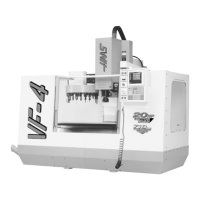PROGRAMMING EXAMPLES
24596-8000
June 1999
PROGRAMMABLE M IRROR I MAGE
Programmable mirror image can be turned on or off individually for any of the four axes. The two codes are non-
modal, but the mirror status of each axis is modal. The bottom of the CRT screen will indicate when an axis is
mirrored. These codes should be used in a command block without any other G codes and will not cause any
axis movement. G101 will turn on mirror image for any axis listed in that block. The actual value given for the X,
Y, Z, or A code has no effect and should be entered as zero value.
Example:
G101 X0 = Will turn on mirror image for the X-axis.
G100 X0 = Will turn off mirror image for the X-axis.
Most mirror image applications would consist of irregular pockets and contours and would most likely be set up
in subprograms for convenience.
Note: After completion of the first item, a Z-axis clearance move should be made.
Then, the mirror image should be turned on with an axis specification. The
following line needs the coordinates of the starting location of the original
pocket. The following line will feed to the required Z-axis depth, the next line
would contain a subprogram call or a contour definition, and last, a positive
Z-axis clearance move.
The pockets should be arranged around a given origin, usually described as X0,Y0.
Mirror image and pocket milling exercise for O3600.
Note: When milling a shape with X-Y motions, turning on MIRROR IMAGE for just one
of the X and Y will change climb milling to conventional milling and/or
conventional milling to climb milling. As a result, you may not get the type of
cut or finish that was desired. Mirror image of both X and Y will eliminate this
problem.

